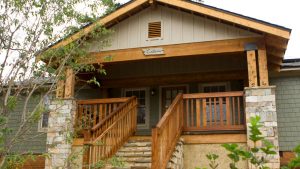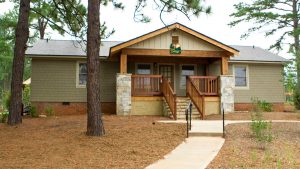Reduce, Reuse, Recycle is the mantra of those who aim to change our practices to a more sustainable way of life. We generally consider these practices as applied to our coffee cups, cardboard boxes and other small household items. But in light of all the new green technologies, how does this apply to our homes? Is it better to build a new home with solar panels, geothermal power and green roof rather than reuse an older home in need of renovations? Two factors led me to consider these questions more deeply, with the first being my participation in Furman’s Greenbelt Community, which has me not only focused on how I can individually alter my impact on our environment, but also how I might make a larger difference as an advocate for changes in the larger community. The second factor is my family’s recent move to Spartanburg and our decision to make a difference in our new community through real estate investing, with an ultimate goal of providing housing for families facing homelessness. As we began to meet other people involved in real estate, it came to our attention that Spartanburg city prefers to demolish older homes and sell the lots rather than sell the home to someone willing to restore it. This seemed wasteful to me, but I had no idea which practice was more sustainable — restoration of the old or building newer, greener homes.
Before addressing the environmental impact, one factor that must be considered in this discussion is the loss of history. Take this beautiful historic home in Spartanburg, Bon Haven, built in 1884 with many architectural details not seen in today’s modern homes (Image 1). Although a couple offered to purchase the home and restore it to its historic beauty, the city opted to allow its demolition. This home and its history were lost to us in September of 2017. But maybe the impact on the environment of a home that was built a century before green technologies began to be widely applied in construction has too much of a negative impact to warrant its saving?

Image 1: Bon Haven built in 1884 and approved for demolition February of 2017
This is the question that I sought to answer as I began to read about new construction vs restoration. Does the practice of reusing for environmental sustainability not apply to homes? As I suspected, studies have been done to gather data to answer this question. Since I have seen much celebration of new “green” homes built with technologies aimed at sustainability, I assumed building a green home would be better for the environment than restoring an older home. While some appreciation is shown for beautiful restorations, I have never seen the environmental community celebrate these restorations like seen with net zero new builds. But the data tells us we should actually advocate for and celebrate each time an old home or building is restored to be reused. A 2012 study of this issue showed that the benefits of reusing older homes and buildings outweighed the environmental benefits of newer more energy efficient construction. The impact of the newer technologies takes 10-80 years to overcome the negative impact of the new construction. The study determined that if the city of Portland restored rather than demolished buildings over the next 10 years, it would lead to a reduction of 231,000 metric tons of carbon.
Living in the Greenbelt community, I have the opportunity to experience green technologies that allow me to leave a smaller footprint on my environment. The use of thermal hot water and solar lighting allows me to enjoy a hot shower and study late into the night without the worries of how this energy use will negatively impact the future of our environment. Thankfully, the Furman community recognized the importance of applying the principle of reusing as they prepared this more sustainable living accommodation. Our housing was built in the 1970s (Image 2) and retrofitted with the new green technologies! Sustainability advocates need to look at all aspects of environmental impact-sometimes new and trendy is not the most sustainable practice. We may be able to preserve history while also using the amazing technologies developed to lessen our footprint.


Image 2: The cabin and the cottage in Furman’s Greenbelt Community
Sources:
https://www.countryliving.com/life/news/a42776/south-carolina-bon-haven-mansion-to-be-demolished/
https://www.buildings.com/articles/31503/new-construction-vs-renovation-which-greener
https://www.wspa.com/news/bon-haven-demolished-in-spartanburg/